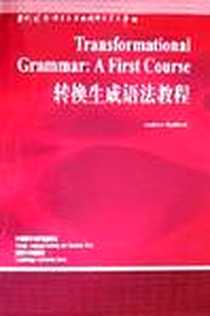《转换生成语法教程》
《转换生成语法教程》
出版时间:2000-8-1
出版社:牛津大学出版社
作者:Andrew Radford
页数:630
《转换生成语法教程》内容概要[E]
Andrew Radford's new textbook is principally for students with
little or no background in syntax who need a lively and up-to-date
introduction to contemporary work on transformational grammar. It
covers four main topies-the function of transformations and the
principles governingtheir application. The framework takes into
account the major works such as Chomsky's Knowledge of Language and
Barriers wirtten since the publication of Radford's widely
acclaimed Transformational Syntax in 1981. Not only does the
present book use a more recent theoretical framework. but at the
descriptive level it covers a wider range of constructions and
rules than its predecessor. Andrew Radford is well known for his
effective pedagogical approach, and in this book even more care has
been devoted to providing a sympathetic and non-technical
introduction to the field. At the end of each chapter are exercises
which reinforce the text, enable sutdents to apply the various
concepts, etc. discussed, or encourage them to look more critically
at some of the saaumptions and analyses presented. The book also
has a detailed bibliographical background section and an extensive
bibliography which will be a useful source of reference to the
primary literature. Although intended principally as a
coursebookfor students of syntax or English grammar.
Transformational Grammar will be invaluable to any reader who needs
a straightforward and comprehensive introduction to the latest
developments in this field.
《转换生成语法教程》书籍目录[E]
Preface by Halliday
王宗炎序
导读
Prologue
Acknowledgments
1 Goals
1.1 Overview
1.2 Grammatical competence
1.3 Basic concepts and fundamental misconceptions
1.4 Competence as infinite rule-governed creativity
1.5 Discovering the rules
1.6 Levels of adequacy
1.7 Constraining grammars
1.8 Constraints,universals,and acquisition
1.9 Markedness and Core Grammar
1.10 Summary
Exercises
2 Structure
2.1 Overview
2.2 Intuitions about Structure
2.3 Word-level categories
2.4 Phrasal categories:nonsyntactic evidence
2.5 Phrasal categories:distributional evidence
2.6 Phrasaal categories:other syntactic evidence
2.7 Words used as Phrases
2.8 Testing the Structure
2.9 Summary
Exercises
3 Phrase-markers
3.1 Overview
3.2 The nature of Phrase-markers
……
4 Noun Phrases
5 Other Phrases
6 Clauses
7 The Lexicon
8 Transformations
9 WH MOVEMENT
10 ALPHA MOVEMENT